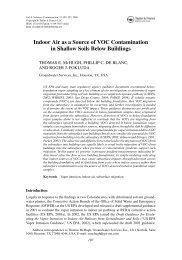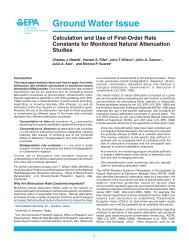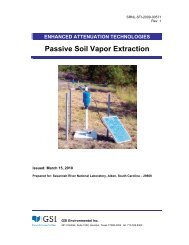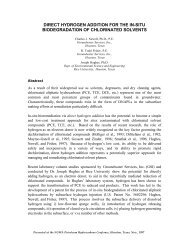Parameter Estimation Guidelines for Risk-Based Corrective Action ...
Parameter Estimation Guidelines for Risk-Based Corrective Action ...
Parameter Estimation Guidelines for Risk-Based Corrective Action ...
Create successful ePaper yourself
Turn your PDF publications into a flip-book with our unique Google optimized e-Paper software.
TABLE 3. PARAMETER SELECTION GUIDELINES: LATERAL GROUNDWATER TRANSPORT MODEL (EQUATION LT-1) continued<br />
Input <strong>Parameter</strong><br />
Symbol Description Typical Range <strong>Parameter</strong> Measurement or <strong>Estimation</strong> <strong>Guidelines</strong> Reference<br />
REASONABLE PARAMETER ESTIMATES (CONT'D)<br />
α x<br />
α y<br />
α z<br />
Groundwater dispersivity coefficients in longitudinal<br />
(x), transverse (y), and vertical (z) dimensions<br />
----- For use with biodegradation functions in Domenico model (LT-1a or<br />
LT-1b), reasonable dispersivity estimates may be derived as follows:<br />
Longitudinal Dispersivity:<br />
−2.<br />
414<br />
⎡ ⎛ X ⎞⎤<br />
α x = 3.28• 0.83•<br />
⎢log 10 ⎜ ⎟<br />
⎣ ⎝ 3.28⎠<br />
⎥<br />
⎦<br />
Transverse Dispersivity: α y = 0.10 alpha x<br />
(based on high reliability points from Geihar et al, 1992)<br />
Vertical Dispersivity: α z = very low (i.e., 1 x 10 -99 ft)<br />
(based on conservative estimate)<br />
Xu and Eckstein, 1995<br />
Gelhar et al, 1992<br />
Newell et al, 1996<br />
Other commonly used relationships include:<br />
Pickens and Grisak, 1981<br />
ASTM, 1995<br />
α x = 0.1 • X<br />
EPA, 1986<br />
α y = 0.33 • α x<br />
α z = 0.025 to 0.1 • α x<br />
[Note: If used with electron-acceptor superposition version of<br />
Domenico model (Equation LT-1b), these later relationshipos may<br />
result in overestimation of biodegradation effects.]<br />
λ e First-order degradation rate <strong>for</strong> constituent i (sec -1 ) ------ Optional methods <strong>for</strong> selection of appropriate decay coefficients <strong>for</strong> Newell et al, 1996<br />
each constituent of concern are as follows:<br />
Connor et al, 1995<br />
Calibrate to Existing Plume Data: If the plume is in a steady-state or Connor et al, 1994<br />
diminishing condition, the BIOSCREEN or FATE II models can be used<br />
to determine first-order decay coefficients that best match the<br />
observed site concentrations. This site-specific calibration ef<strong>for</strong>t will<br />
require representative measurements of each constituent along the<br />
centerline of the groundwater plume. Detailed instructions are<br />
provided in the BIOSCREEN and FATE II User's Guides.<br />
Literature Values: If the plume is in an expanding condition or if a<br />
preliminary estimate of biodegradation effects is desired, decay halflife<br />
values <strong>for</strong> hydrolysis and biodegradation from published<br />
references (e.g., see Howard et al, 1991). Note that many references<br />
report the half-lives; these values can be converted to the first-order<br />
decay coefficients using k = 0.693/t 1/2 (see dissolved plume half-life).<br />
In the absence of site-specific calibration data, minimum values<br />
(maximum half-life values) should be used. The selected values should<br />
correspond to the half-life <strong>for</strong> full constituent decay to non-hazardous<br />
progeney. For inorganics, λ = 0.<br />
NOTE: See Equation LT-1 on Figure 3 regarding use of the above parameters <strong>for</strong> estimation of steady-state groundwater dilution attenuation factor <strong>for</strong> dissolved groundwater plume. Detailed<br />
discussion of this groundwater solute transport model is provided in the Tier 2 RBCA Guidance Manual (see Connor et al, 1995).<br />
NGWA Petroleum Hydrocarbons Conference 18 <strong>Parameter</strong> <strong>Estimation</strong> <strong>Guidelines</strong><br />
Houston, Texas, November 1996<br />
<strong>for</strong> RBCA Modeling






